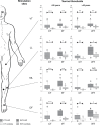New insights into the clinical evaluation of hereditary transthyretin amyloidosis patients: a single center's experience
- PMID: 30890882
- PMCID: PMC6065582
- DOI: 10.2147/DNND.S24652
New insights into the clinical evaluation of hereditary transthyretin amyloidosis patients: a single center's experience
Abstract
Over the last decade, new medical treatment modalities have emerged based on increased insights into amyloid formation. With the increased possibilities for treatment of amyloidosis caused by transthyretin (TTR) amyloid deposits comes the need for diagnostic procedures for early diagnosis and better tools to follow disease progression. This is of particular importance in clinical trials evaluating the efficacy of new treatments. Until recently, the treatment of TTR amyloidosis (ATTR) was based solely on liver transplantation, a procedure that has halted disease progression in many patients. Liver transplantation has been especially effective in patients under the age of 50 years carrying the TTR V30M mutation, whereas the outcome of the procedure has been variable for others, particularly elderly male patients and those carrying a non-V30M mutation. This review concentrates on new insights derived from our center's experience with liver transplantation, how to implement this experience in evaluation of new treatment modalities for ATTR, and how to facilitate early diagnosis of neuropathy with easily available diagnostic tools. Attention has focused on manifestations of the disease that involve the heart and the peripheral nervous system; change in peripheral nerve function has been the primary endpoint in two controlled clinical trials, one finished and one ongoing. New insights into the amyloid formation process and the lessons learned from liver transplantation give the opportunity to design potentially effective treatment modalities for ATTR. It appears reasonable to suspect that a combination of different treatment modalities may be required to treat the disease, and that different treatment regimes will be designed according to the phenotype of the disease. For the patients and their relatives there is now a solid foundation for optimism, with prospects of several effective medical treatment possibilities within the coming decade.
Keywords: amyloid; cardiomyopathy; diagnostic tools; neuropathy; new treatment modalities.
Conflict of interest statement
Disclosure OBS has served as a consultant for Pfizer, Alnylam Pharmaceuticals, and Isis Pharmaceuticals companies. OBS has participated as an investigator in clinical trials with tafamidis, diflunisal, and small interfering RNA. EN received lecture honoraria from Ipsen and Pfizer. The authors have no other conflicts of interest to report.
Figures



Similar articles
-
Liver transplantation in transthyretin amyloidosis: issues and challenges.Liver Transpl. 2015 Mar;21(3):282-92. doi: 10.1002/lt.24058. Epub 2015 Feb 2. Liver Transpl. 2015. PMID: 25482846 Review.
-
Transthyretin (ATTR) amyloidosis: clinical spectrum, molecular pathogenesis and disease-modifying treatments.J Neurol Neurosurg Psychiatry. 2015 Sep;86(9):1036-43. doi: 10.1136/jnnp-2014-308724. Epub 2015 Jan 20. J Neurol Neurosurg Psychiatry. 2015. PMID: 25604431 Review.
-
CNS involvement in V30M transthyretin amyloidosis: clinical, neuropathological and biochemical findings.J Neurol Neurosurg Psychiatry. 2015 Feb;86(2):159-67. doi: 10.1136/jnnp-2014-308107. Epub 2014 Aug 4. J Neurol Neurosurg Psychiatry. 2015. PMID: 25091367
-
Characteristics of Patients with Hereditary Transthyretin Amyloidosis-Polyneuropathy (ATTRv-PN) in NEURO-TTRansform, an Open-label Phase 3 Study of Eplontersen.Neurol Ther. 2023 Feb;12(1):267-287. doi: 10.1007/s40120-022-00414-z. Epub 2022 Dec 16. Neurol Ther. 2023. PMID: 36525140 Free PMC article.
-
Genetic and clinical characteristics of hereditary transthyretin amyloidosis in endemic and non-endemic areas: experience from a single-referral center in Japan.J Neurol. 2018 Jan;265(1):134-140. doi: 10.1007/s00415-017-8640-7. Epub 2017 Nov 24. J Neurol. 2018. PMID: 29177547
Cited by
-
Misfolding of transthyretin in vivo is controlled by the redox environment and macromolecular crowding.J Biol Chem. 2025 Jan;301(1):108031. doi: 10.1016/j.jbc.2024.108031. Epub 2024 Nov 28. J Biol Chem. 2025. PMID: 39615680 Free PMC article.
References
-
- Hammarström P, Wiseman RL, Powers ET, Kelly JW. Prevention of transthyretin amyloid disease by changing protein misfolding energetics. Science. 2003;299(5607):713–716. - PubMed
-
- Kelly JW, Colon W, Lai Z, et al. Transthyretin quaternary and tertiary structural changes facilitate misassembly into amyloid. Adv Protein Chem. 1997;50:161–181. - PubMed
-
- Benson MD, Kincaid JC. The molecular biology and clinical features of amyloid neuropathy. Muscle Nerve. 2007;36(4):411–423. - PubMed
-
- Connors LH, Lim A, Prokaeva T, Roskens VA, Costello CE. Tabulation of human transthyretin (TTR) variants, 2003. Amyloid. 2003;10(3):160–184. - PubMed
-
- Jacobson DR, Pastore RD, Yaghoubian R, et al. Variant-sequence transthyretin (isoleucine 122) in late-onset cardiac amyloidosis in black Americans. N Engl J Med. 1997;336(7):466–473. - PubMed
Publication types
LinkOut - more resources
Full Text Sources
Research Materials
Miscellaneous

